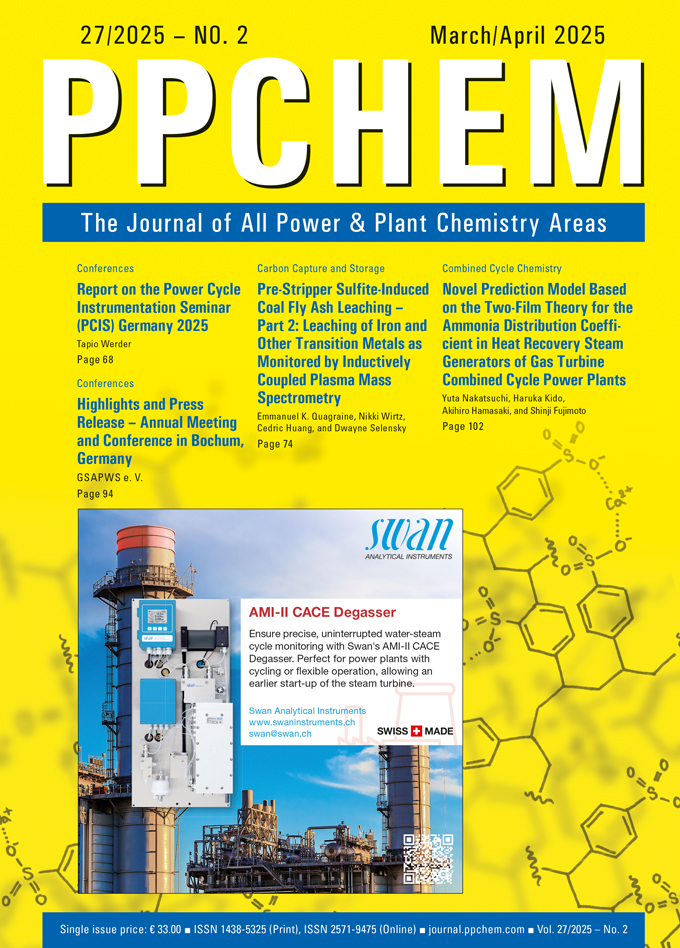
For members only
ABSTRACTS
Report on the Power Cycle Instrumentation Seminar (PCIS) Germany 2025
Tapio Werder
For the second time, the Power Cycle Instrumentation Seminar (PCIS) series made a stop in Germany. The PCIS Germany 2025 in Aachen was held under the patronage of PPCHEM AG, with financial sponsorship from SWAN Analytical Instruments and REICON Wärmetechnik und Wasserchemie Leipzig GmbH.
The PCIS series focuses on the analytical methods, the sampling points, and the critical issues for each parameter. The emphasis lies on spreading knowledge of cycle chemistry and an understanding of analytical instruments. The seminar provides a well-proven mixture of theoretical background information on cycle chemistry, sampling, and monitoring as well as a deeper look into analytical methods and critical issues for each parameter, concerning operation, verification, and calibration. This report summarizes the two days of the PCIS Germany 2025.
PPCHEM® 2025, 27(2), 68–71
For Members only
Pre-Stripper Sulfite-Induced Coal Fly Ash Leaching – Part 2: Leaching of Iron and Other Transition Metals as Monitored by Inductively Coupled Plasma Mass Spectrometry
Emmanuel K. Quagraine, Nikki Wirtz, Cedric Huang, and Dwayne Selensky
This is Part 2 of a series of investigations on understanding the impact SO2 in flue gas (FG) has on an integrated amine solvent based sulfur dioxide (SO2) and carbon dioxide (CO2) capturing process such as practiced at the Boundary Dam Unit 3 carbon capture and storage plant. It follows the Part 1 article on the effect of SO2 on coal fly ash (CFA) leaching of iron and extends it to other transition metals (TMs) that may potentially cause oxidative degradation of amines used in the process. The results confirm the findings in Part 1 that, apart from pH on its own, SO2 and its pH-speciated aqueous forms affect the leaching of TMs and potentially catalyze degradation of amines used to capture acidic contaminants from post-combustion FG. The sulfite-induced leaching of TMs occurred primarily under acidic conditions that simulate pre-scrubber and amine-based SO2 capture conditions (pH ≤ 6). This occurred either exclusively (e.g., for iron) under acidic conditions, or additionally also in alkaline solutions – substantially for copper when at 50 °C, but only moderately for vanadium and titanium (and copper when at 90 °C). The alkaline leachates that represent conditions of the post-combustion CO2 capture process are as follows for a caustic chimney tray fly ash (CCTF) sample: copper (Cu) > iron (Fe) > vanadium (V) > titanium (Ti) > nickel (Ni) > chromium (Cr) > manganese (Mn); and for a flue gas cooler inlet fly ash (FGCIF) sample: V > Fe > Mn > Ti > Cu > Ni > Cr. However, TMs leached more under the acidic conditions (pH 4 to 6) that better represent the SO2 capture process, and the leaching order is as follows for CCTF: Fe > Cu > V > Ti > Mn > Cr > Ni; and for FGCIF: Fe > Mn > Ti > V > Ni > Cu > Cr.
PPCHEM® 2025, 27(2), 74–91
For Members only
Highlights and Press Release Annual Meeting and Conference in Bochum, Germany
GSAPWS e.V.
The German-Swiss Association for the Properties of Water and Steam (GSAPWS) e.V. held its annual general meeting and conference on March 6 and 7, 2025. This year, the events took place at Ruhr University Bochum.
PPCHEM® 2025, 27(2), 94–95
For Members only
Novel Prediction Model Based on the Two-Film Theory for the Ammonia Distribution Coefficient in Heat Recovery Steam Generators of Gas Turbine Combined Cycle Power Plants
Yuta Nakatsuchi, Haruka Kido, Akihiro Hamasaki, and Shinji Fujimoto
In a combined cycle power plant with a heat recovery steam generator, ammonia and hydrazine are injected into the boiler feedwater, while sodium phosphate is used in the drum boiler water. However, hydrazine is suspected to cause health problems, and sodium phosphate may cause phosphoric acid corrosion. An alternative method has been applied in recent years wherein only ammonia is used for water treatment. Although the ammonia concentration in the drum boiler water depends on the gas-liquid distribution coefficient of ammonia, the measured result of the gas-liquid distribution coefficient in the actual plants is found to be smaller than the reported value in the equilibrium state. This is because the boiler feedwater passes through the drum boiler before attaining equilibrium. In this study, a novel dynamic model for the gas-liquid distribution of ammonia between the drum boiler water and the drum boiler steam was investigated by applying the two-film theory. Using this novel model, the ammonia gas-liquid distribution coefficient in the drum boiler can be estimated more accurately. Furthermore, the ammonia concentration of the boiler feedwater can be determined, even in a water treatment system with only ammonia, which is effective in preventing flow-accelerated corrosion of the drum boiler.
PPCHEM® 2025, 27(2), 102–112
For Members only
Erratum
Nobody is perfect and everybody makes mistakes sometimes. We apologize to the authors and to our readers for the mistakes in this article:
PPCHEM® 2025, 27(2), 73

